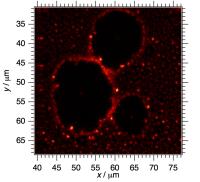Article,
Thermally Activated Delayed Fluorescence Host for High Performance Organic Light-Emitting Diodes
Scientific Reports, 8 (1): 8832-- (2018)
DOI: 10.1038/s41598-018-27238-y
Abstract
Thermally activated delayed florescence (TADF) materials can be an efficient host in organic LED (OLED). It is because it is possible to couple energetically the emission energy level of a dopant to the energy levels in the TADF material. In this work fluorescent emitters 2,3,6,7-tetrahydro-1,1,7,7,-tetramethyl-1H,5 H,11H-10-(2-benzothiazolyl)quinolizino-9,9a,1gh coumarin (c545t) and 5,6,11,12-tetraphenyltetracene (rubrene) were used as dopants in a blended TADF host; tris(4-carbazoyl-9-ylphenyl)amine (TCTA) with 2,4,6-tris(3′-(pyridin-3-yl)biphenyl-3-yl)-1,3,5-triazine (Tm3PyBPZ). The blended TADF host has an energy difference between the singlet and triplet excited states (ΔEST) around 27 meV with the yield of reverse intersystem crossing (ФRISC) nearly 100%. This high ФRISC yield enhances the OLED performance with the c545t doped OLED having 11.9% external quantum efficiency and 10% for the rubrene doped OLED.
